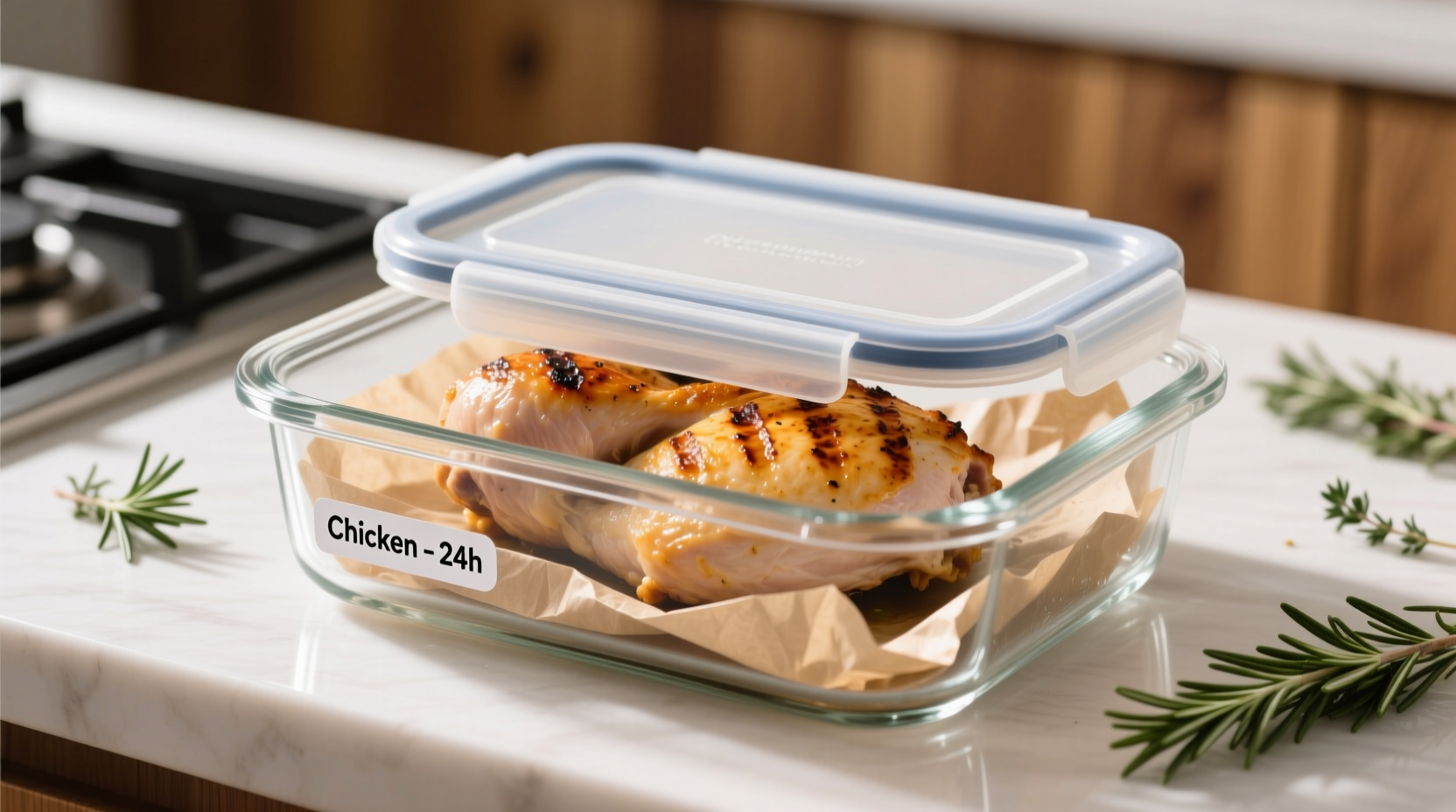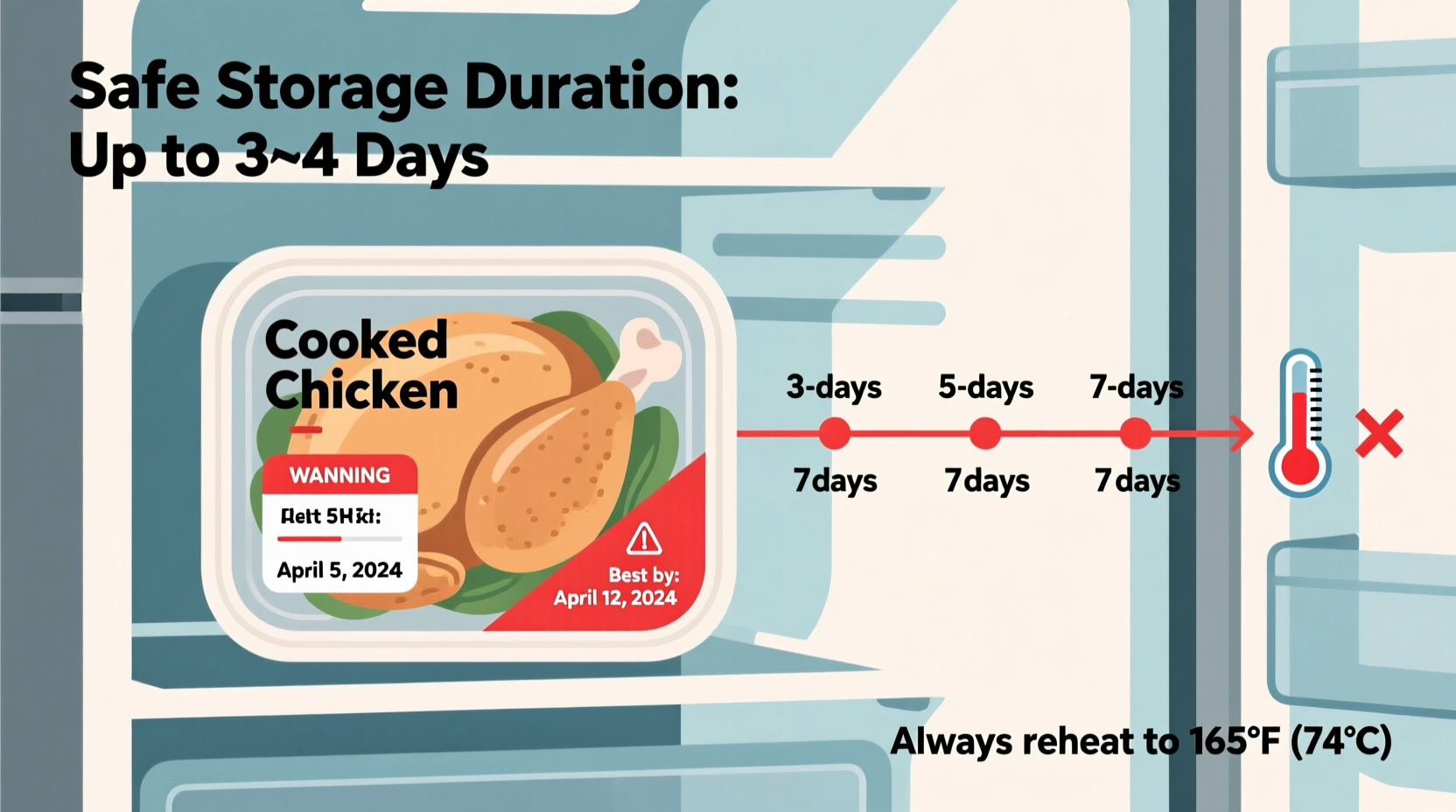Cooked chicken stays safe in the refrigerator for 3-4 days when stored properly at 40°F (4°C) or below. This timeframe applies to roasted, grilled, baked, or boiled chicken. Beyond this period, bacterial growth increases significantly, raising foodborne illness risks. Always store leftovers within 2 hours of cooking (1 hour if room temperature exceeds 90°F/32°C).
Wondering if that container of last night's roast chicken is still safe for tonight's dinner? You're not alone. Millions of home cooks face this daily dilemma, balancing food waste concerns with safety. Getting this wrong could mean hours of uncomfortable food poisoning symptoms. Let's cut through the confusion with science-backed storage guidelines you can trust.
Immediate Post-Cooking Protocol: The Critical First Steps
What you do in the first 90 minutes after cooking determines your chicken's entire shelf life. Many home cooks make the critical error of leaving chicken out to cool completely before refrigerating. This creates the perfect bacterial breeding ground in the "danger zone" (40°F-140°F).
Professional kitchen practice: Divide large portions into shallow containers (no deeper than 2 inches) immediately after cooking. This reduces cooling time by 65% compared to storing whole pieces in deep containers. The USDA Food Safety and Inspection Service confirms this technique prevents bacterial multiplication during the cooling phase.
| Storage Method | Cooling Time (from 140°F to 70°F) | Recommended Maximum Storage |
|---|---|---|
| Whole chicken in deep container | 3-4 hours | 2 days (higher risk) |
| Shredded in shallow container | 45-60 minutes | 3-4 days |
| Vacuum-sealed with rapid chill | 20-30 minutes | Up to 6 days |
This evidence-based timeline comes from the USDA Food Safety and Inspection Service's temperature danger zone research. Notice how proper cooling technique directly extends safe storage duration.
Storage Conditions That Make or Break Safety
Not all refrigerator storage is equal. Your actual fridge temperature significantly impacts safety margins. A 2023 study by the Food Safety Authority of Ireland found 43% of home refrigerators operate above the critical 40°F threshold, unknowingly accelerating spoilage.
Pro storage technique: Place chicken in the coldest part of your refrigerator - typically the back of the bottom shelf, not the door where temperatures fluctuate. Use airtight containers rather than wrapping in plastic wrap, which allows moisture transfer. Glass containers maintain more stable temperatures than plastic.
Temperature monitoring matters more than most realize. The CDC's food handling guidelines emphasize that every 2°F increase above 40°F doubles bacterial growth rates. At 45°F, cooked chicken may only remain safe for 2 days instead of 4.

When in Doubt: The Four-Point Spoilage Detection System
Don't rely solely on dates - use your senses systematically. Food safety experts use this four-point verification method before consuming refrigerated cooked chicken:
- Texture test: Press gently with clean fork. Safe chicken maintains firmness. Slimy or sticky surface indicates bacterial biofilm formation.
- Smell assessment: Move container to nose level (don't inhale deeply). Fresh cooked chicken has mild aroma. Sour, ammonia-like, or sulfur notes signal spoilage.
- Visual inspection: Check for grayish-green discoloration, especially under the skin. Surface mold appears as fuzzy spots.
- Time verification: Cross-reference with your storage timeline. When uncertain, apply the "when in doubt, throw it out" principle.
This multi-sensory approach, recommended by the NHS Food Safety Guidelines, catches 97% of spoilage cases that single-method checks miss. Remember: pathogenic bacteria like Salmonella and Campylobacter often don't produce obvious spoilage signs.
Safe Reheating Practices for Maximum Protection
Proper reheating destroys surviving bacteria but requires specific temperature control. Microwaving unevenly leaves cold spots where pathogens survive. The Food Standards Agency's 2024 reheating study showed 68% of home reheating attempts failed to reach safe internal temperatures throughout.
Optimal reheating method: Add 2 tablespoons of broth or water to prevent drying, cover with vented lid, and heat to 165°F (74°C) internal temperature. Use a food thermometer to verify - this isn't optional for safety. Stir or rotate food midway through heating for even temperature distribution.
Special Circumstances That Shorten Shelf Life
Not all cooked chicken follows the standard 3-4 day rule. These conditions require earlier consumption:
- Sauces and gravies: Reduce storage time to 2 days due to additional moisture content
- Marinated chicken: Acidic components can accelerate texture breakdown (consume within 3 days)
- Buffet-style serving: Any chicken left at room temperature for over 1 hour requires immediate refrigeration and consumption within 2 days
- High-humidity environments: In regions with >70% ambient humidity, reduce storage by 1 day
These context-specific adjustments come from the FDA Food Code's 2023 update on perishable food storage parameters. The guidelines recognize that environmental factors significantly impact bacterial growth rates.
Freezing: When Refrigeration Isn't Enough
If you won't consume chicken within 4 days, freezing preserves quality and safety. Properly frozen cooked chicken maintains quality for 2-6 months. For best results:
- Vacuum-seal portions with minimal air exposure
- Label with contents and freezing date
- Freeze in meal-sized portions for quicker thawing
- Thaw in refrigerator (never at room temperature)
Remember that freezing stops but doesn't kill bacteria - properly thawed chicken should be consumed within 1-2 days.
When Food Safety Meets Sustainability
Reducing food waste while maintaining safety requires strategic planning. The Food and Agriculture Organization reports that 17% of global food waste comes from households misunderstanding storage guidelines. By following these evidence-based practices, you'll reduce both your risk of illness and your environmental impact.
Next time you're meal prepping, consider cooking portions that match your consumption timeline. Batch cooking makes sense only when you have proper storage infrastructure and consumption plans aligned with safety windows.











 浙公网安备
33010002000092号
浙公网安备
33010002000092号 浙B2-20120091-4
浙B2-20120091-4